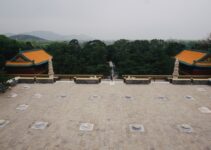The Broken Earth Trilogy by N.K. Jemisin is a groundbreaking series in the science fiction and fantasy genre. Comprised of three books – “The Fifth Season,” “The Obelisk Gate,” and “The Stone Sky” – the trilogy has garnered critical acclaim and numerous awards, including three consecutive Hugo Awards for Best Novel. The series takes place in a post-apocalyptic world where cataclysmic events known as Fifth Seasons have reshaped the planet and its inhabitants. With its rich worldbuilding, complex characters, and thought-provoking themes, The Broken Earth Trilogy has become a significant work in the genre, pushing boundaries and challenging conventions.
Understanding the Post-Apocalyptic World of The Broken Earth Trilogy
The world of The Broken Earth Trilogy is a harsh and unforgiving one. Set in a land known as the Stillness, the series takes place in a post-apocalyptic world where cataclysmic events called Fifth Seasons occur periodically, causing widespread destruction and upheaval. These Seasons are marked by seismic activity, volcanic eruptions, and other geological phenomena that reshape the land and threaten the survival of humanity.
The impact of the Fifth Season on society and individuals is profound. Communities are forced to adapt to survive, building their homes out of stone to withstand the earthquakes and volcanic eruptions that accompany each Season. Individuals with the ability to manipulate earth and control seismic activity, known as orogenes, are both feared and exploited by society. They are seen as dangerous and are often treated as outcasts or slaves.
One of the most fascinating aspects of The Broken Earth Trilogy is its use of geology and earth science in its worldbuilding. Jemisin incorporates scientific concepts such as plate tectonics, volcanism, and seismic activity into her narrative, creating a world that feels both familiar and alien. This attention to detail adds depth and realism to the story, making the cataclysmic events and their impact on the world and its inhabitants all the more believable.
The Characters of The Broken Earth Trilogy: Exploring Their Motivations and Relationships
The Broken Earth Trilogy features a diverse cast of characters, each with their own motivations and arcs. The main protagonist, Essun, is a powerful orogene who embarks on a journey to find her daughter after her village is destroyed in the opening pages of the first book. As the series progresses, Essun’s character evolves, and she becomes a symbol of resilience and strength in the face of adversity.
The importance of family and community is a recurring theme in The Broken Earth Trilogy. Essun’s relationship with her daughter, Nassun, is central to the story, as is her connection to other characters she encounters along her journey. The bonds formed between characters are often complex and fraught with tension, reflecting the harsh realities of the world they inhabit.
Identity and belonging are also explored in depth throughout the trilogy. Characters grapple with questions of who they are and where they fit in a world that often rejects or marginalizes them. This exploration of identity adds depth and nuance to the story, allowing readers to connect with the characters on a personal level.
The Role of Magic in The Broken Earth Trilogy
In The Broken Earth Trilogy, magic takes the form of orogeny – the ability to manipulate earth and control seismic activity. Orogenes are feared and ostracized by society, seen as dangerous and unpredictable. Their powers are both a gift and a curse, as they can bring about both destruction and healing.
The concept of orogeny serves as a metaphor for power and oppression in The Broken Earth Trilogy. Orogenes are seen as a threat to the stability of society, and their abilities are often exploited by those in power. This mirrors real-world systems of oppression, where marginalized groups are often feared and oppressed due to their perceived threat to the status quo.
The ethics of using magic are also explored in the trilogy. Orogenes are taught to suppress their powers and hide their abilities, leading to a sense of shame and self-loathing. The series raises questions about the responsibility that comes with power and the consequences of using it for personal gain.
The Use of Language in The Broken Earth Trilogy: A Critique of Power and Oppression
Language plays a significant role in The Broken Earth Trilogy, serving as a critique of power and oppression. The series explores how language can be used to oppress and marginalize certain groups, as well as the importance of reclaiming language and identity.
In the Stillness, orogenes are referred to as “roggas,” a derogatory term used to dehumanize and demean them. This use of language reflects the systemic oppression and discrimination faced by orogenes in society. By reclaiming the term “orogene” and embracing their identity, characters in the series challenge the power dynamics at play.
The exploration of language extends beyond the use of derogatory terms. Jemisin also delves into the power of naming and how it can shape one’s perception of themselves and others. Characters in The Broken Earth Trilogy often adopt new names or titles as they navigate their identities, highlighting the importance of self-definition and agency.
The Broken Earth Trilogy and Social Justice: Addressing Issues of Racism, Sexism, and Classism

The Broken Earth Trilogy tackles issues of systemic oppression and discrimination head-on. Through its exploration of power dynamics, the series addresses issues of racism, sexism, and classism in a thought-provoking and nuanced way.
The world of The Broken Earth Trilogy is divided into different social classes, with orogenes at the bottom of the hierarchy. This mirrors real-world systems where marginalized groups are often relegated to the fringes of society. By shining a light on these issues, the series encourages readers to critically examine the power structures at play in their own lives.
Representation and diversity are also important themes in The Broken Earth Trilogy. The series features a diverse cast of characters, including people of color, LGBTQ+ individuals, and characters with disabilities. This commitment to representation challenges the conventions of the genre and highlights the importance of diverse and inclusive literature.
The impact of The Broken Earth Trilogy on discussions of social justice issues cannot be overstated. The series has sparked conversations about representation, power dynamics, and systemic oppression, encouraging readers to examine their own biases and challenge the status quo.
The Importance of Worldbuilding in The Broken Earth Trilogy
The worldbuilding in The Broken Earth Trilogy is intricate and detailed, creating a rich and immersive reading experience. Jemisin’s attention to detail brings the world of the Stillness to life, making it feel both familiar and alien.
The use of worldbuilding in the series goes beyond creating a backdrop for the story. It serves as a vehicle for exploring themes and ideas. The cataclysmic events and their impact on society provide a lens through which to examine power dynamics, oppression, and resilience.
The worldbuilding also plays a crucial role in immersing the reader in the story. The vivid descriptions of the landscape, the unique terminology used by characters, and the rich history of the Stillness all contribute to a sense of place that draws readers in and keeps them engaged.
The Narrative Structure of The Broken Earth Trilogy: A Study in Non-Linear Storytelling
The Broken Earth Trilogy employs a non-linear narrative structure, using multiple timelines and perspectives to tell its story. This non-linear structure adds depth and complexity to the narrative, allowing readers to piece together the events of the past and present.
The use of multiple timelines and perspectives also serves as a reflection of memory and trauma. Characters in the series grapple with their pasts and the impact of their experiences on their present selves. The non-linear structure allows for a deeper exploration of these themes, highlighting the ways in which memory and trauma shape our identities.
The impact of the non-linear structure on the reader’s experience cannot be overstated. It requires active engagement and attention to detail, rewarding readers with a deeper understanding of the story and its characters.
The Broken Earth Trilogy and the Science Fiction Genre: Breaking Boundaries and Challenging Conventions
The Broken Earth Trilogy has had a significant impact on the science fiction and fantasy genre. Its groundbreaking narrative, complex characters, and thought-provoking themes have pushed boundaries and challenged conventions.
The trilogy’s three consecutive Hugo Awards for Best Novel are a testament to its impact on the genre. It has been praised for its originality, its exploration of new ideas and themes, and its commitment to diverse representation.
The series has also sparked conversations about the role of science fiction in addressing social justice issues. By tackling issues of racism, sexism, and classism head-on, The Broken Earth Trilogy has shown that science fiction can be a powerful tool for examining and critiquing the world we live in.
The Legacy of The Broken Earth Trilogy: Its Impact on Literature and Society
The Broken Earth Trilogy has left a lasting impact on both literature and society. Its exploration of themes such as power, oppression, and resilience has resonated with readers around the world.
The trilogy’s themes and ideas continue to be discussed in contemporary conversations about social justice and representation. It has inspired other authors to push boundaries and challenge conventions in their own work, leading to a more diverse and inclusive landscape in literature.
The importance of diverse and inclusive literature cannot be overstated. Stories like The Broken Earth Trilogy have the power to shape society’s values and beliefs, challenging existing power structures and encouraging empathy and understanding.
The Broken Earth Trilogy by N.K. Jemisin is a groundbreaking series that has had a profound impact on the science fiction and fantasy genre. With its rich worldbuilding, complex characters, and thought-provoking themes, the trilogy pushes boundaries and challenges conventions.
The series explores a post-apocalyptic world shaped by cataclysmic events and examines the impact of power and oppression on society and individuals. It tackles issues of racism, sexism, and classism head-on, sparking important conversations about social justice.
The Broken Earth Trilogy’s legacy extends beyond literature. Its impact on discussions of social justice and representation has shaped contemporary conversations and inspired other authors to push boundaries in their own work.
In conclusion, The Broken Earth Trilogy is a must-read for fans of science fiction and fantasy. Its intricate worldbuilding, complex characters, and thought-provoking themes make it a standout series in the genre. By engaging with this trilogy, readers can explore important issues and challenge their own beliefs, making it a truly transformative reading experience.
If you’re a fan of N.K. Jemisin’s “The Broken Earth Trilogy” and can’t get enough of her captivating storytelling, you’ll definitely want to check out this related article on the series. This insightful piece delves into the themes and symbolism found throughout the trilogy, offering a deeper understanding of Jemisin’s masterful world-building and character development. Discover how Jemisin weaves together elements of science fiction, fantasy, and social commentary to create a truly unique reading experience. Don’t miss out on this must-read article! Click here to explore it further.



